

Educational Technology and Mobile Learning: flipped classroom. Limited Flipped Classroom Pilot Yields Impressive Qualitative, Quantitative Results. On Sunday I shared some exciting Quantitative Results from a pilot of flipped learning that we tried this year at The College of Westchester.

Today we continue this look at our experience, with a focus on the Qualitative feedback offered by our students. This first of two phases of a flipped teaching and learning pilot consisted of two courses in which selected portions of course content (roughly 30% to 50% of the content) were flipped. Further details are provided in Part 1 of this recap.
Qualitative Assessment Approach Quantitative and qualitative assessment techniques were designed and incorporated into our pilot study. Five questions were asked on a survey to gauge student’s perception of how the flipped delivery method affected their learning. It should be noted that these were small groups of students (9 and 11) and that majority of students in each of these course offerings (18 out of 20 total) completed the surveys. Question No. 1: “I liked this approach to learning” Next Steps. Flipped-Learning Toolkit: Flipping the Non-Flippable Classes. Editor's Note:This post was co-authored by Aaron Sams, Managing Director of FlippedClass.com and founding member of the Flipped Learning Network.
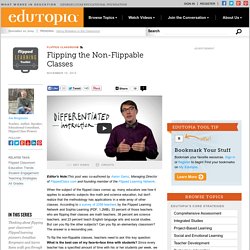
When the subject of the flipped class comes up, many educators see how it applies to academic subjects like math and science education, but don't realize that the methodology has applications in a wide array of other classes. According to a survey of 2358 teachers by the Flipped Learning Network and Sophia Learning (PDF, 1.2MB), 33 percent of those teachers who are flipping their classes are math teachers, 38 percent are science teachers, and 23 percent teach English language arts and social studies. But can you flip the other subjects? 9 Video Tips for a Better Flipped Classroom. Flipped Classroom | November 2013 Digital Edition 9 Video Tips for a Better Flipped Classroom Early adopters share how schools can find success with teachers and students alike--even when the technology seems as topsy-turvy as the lessons.
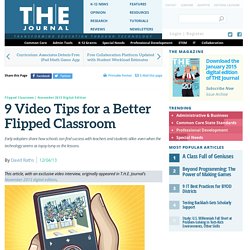
In 2007, when Colorado high school teachers Jonathan Bergmann and Aaron Sams began experimenting with recording their lectures in order to spend class time on deeper face-to-face learning with students, they probably didn't foresee the major movement that would grow up around what came to be called the flipped classroom. But six years later, the growth in interest remains exponential, suggesting this is far more than a fad.
Just since January 2012, the number of active members on the Flipped Learning Network's Ning site has grown from 2,500 to more than 15,000. Today, it seems, there is no one correct way to flip the classroom, and approaches vary both by subject and educational philosophy. 1) Devise a flipped strategy. About flipping. Flipped Classroom. Flipping Web Sites. The Flipped Classroom. Flipped Classroom Resources. Flipping the classroom. Tablet Academy - Flipping the Classroom Research. 'Flipping the Classroom' The flipped classroom model involves the use of technology and online media to improve the learning in your classroom.
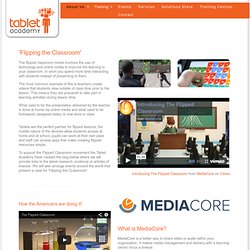
In short you spend more time interacting with students instead of presenting to them. The most common example of this is teachers create videos that students view outside of class time prior to the lesson. This means they are prepared to take part in learning activities during lesson time. What used to be the presentation delivered by the teacher is done at home via online media and what used to be homework (assigned tasks) is now done in class. Tablets are the perfect partner for flipped lessons, the mobile nature of the devices allow students access at home and at school, pupils can work at their own pace and staff can access apps that make creating flipped resources simple.
Flipping The Classroom… A Goldmine of Research and Resources To Keep You On Your Feet. Greetings from Boston and BLC12 (Alan November’s Building Learning Communities Conference ). If you wish to follow the happenings at BLC12 check out the hashtag #BLC12 on Twitter. Welcome to another post rich in resources on the Flipped Classroom. If you have come here looking for links that will guide you to videos and multimedia to use in a Flipped Classroom you will find that in the second half of this post. Perhaps you have tried a little Flip of your own and want to learn more.
If you are beginning to investigate what a Flipped Classroom is, with the thought of possibly trying some kind of Flip yourself… then this is also the right place. Quick Note – I have been getting a lot of request asking if I will make a visit to your school, organization, or conference. Flipped instruction. The Flipped Classroom: Pro and Con. In 2012, I attended the ISTE conference in San Diego, CA.
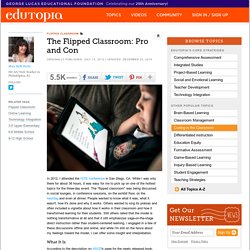
While I was only there for about 36 hours, it was easy for me to pick up on one of the hottest topics for the three-day event. The "flipped classroom" was being discussed in social lounges, in conference sessions, on the exhibit floor, on the hashtag and even at dinner. People wanted to know what it was, what it wasn't, how it's done and why it works. Others wanted to sing its praises and often included a vignette about how it works in their classroom and how it transformed learning for their students.
Still others railed that the model is nothing transformative at all and that it still emphasizes sage-on-the-stage direct instruction rather than student-centered learning. What It Is The authors go on to explain that the model is a mixture of direct instruction and constructivism, that it makes it easier for students who may have missed class to keep up because they can watch the videos at any time. What It Isn't. The Flipped Classroom: Turning the Traditional Classroom on its Head. Flip Classroom Instruction: How to Guide Part 1 - Educational Technology Tips. Flip Classroom Instruction, Reverse Instruction, Flipped Instruction, and Flipped Classroom are all names for the same instructional method.
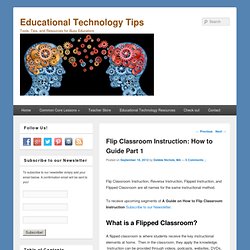
To receive upcoming segments of A Guide on How to Flip Classroom Instruction Subscribe to our Newsletter. A flipped classroom is where students receive the key instructional elements at home. Then in the classroom, they apply the knowledge. Instruction can be provided through videos, podcasts, websites, DVDs, CDs, or any other form that provides a clear instructional message. Flip Classroom Instruction: How to Guide Part 1 - Educational Technology Tips. www.flippedlearning.org/cms/lib07/VA01923112/Centricity/Domain/41/FLIP_handout_FNL_Web.pdf. Time-shifting instruction: flipped classroom and teaching. Flip Your Classroom. How flipping works for you Save time; stop repeating yourself Record re-usable video lessons, so you don't have to do it again next year.

It's easy to make minor updates to perfect lessons over time once the initial recording is done. Let students take control of their learning Not all students learn at the same pace. Spend more time with students Build stronger student-teacher relationships, and promote higher level thinking. Other teachers are doing it, you can too Stacey Roshan found that the traditional classroom model wasn't cutting it for her AP students, so she flipped her class.
Watch Stacey's Story Crystal Kirch started using videos as instructional tools in her class but soon realized the real value of flipping lectures was being able to spend more face-to-face time with students. Read Crystal's Story Tools You Can Use. The Flipped Classroom.